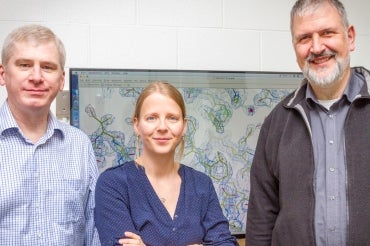Plastic makes perfect? U of T researchers discover plastic helps them stabilize protein molecules to generate 3D structures

Published: February 7, 2017
University of Toronto scientists have discovered a better way to extract proteins from the membranes that encase them, making it easier to study how cells communicate with each other to create human health and disease.
In a study published today on the cover of the journal Structure, Jana Broecker, a postdoctoral fellow in the lab of Biochemistry Professor Oliver P. Ernst, along with colleagues has discovered that a type of plastic or polymer – originally developed by the auto industry – can be used to better stabilize crucial proteins, thereby making them available for 3D structure determination.
The ability to determine the 3D atomic structure of protein molecules is critical in understanding how they work and how they will respond to drug therapies.
Along with Broecker's research which will help stabilize proteins, U of T researchers led by U of T Scarborough PhD student Ali Punjani earlier this week released a study showing that they've developed a new set of machine learning algorithms to generate 3D structures of tiny protein molecules, thus revolutionizing the development of drug therapies for a range of diseases.
Read more about Punjani's research
Scientists are interested in understanding how membrane proteins work and why they malfunction under certain circumstances.
Looking at their 3D structures is a particularly useful way to do this. Currently, researchers use detergents to separate proteins from their fatty membrane casing for further in-detail studies. But detergent strips the fat molecules away from the proteins, which very often destabilizes the proteins and makes them useless for study. As a result, new 3D structures are rarely discovered and published.
The polymers don’t strip off fat molecules from the proteins, instead wrapping themselves around the protein, with the fat molecules still attached, says Broecker of U of T Faculty of Medicine's department of biochemistry. Using the new substance, she was able to keep these necessary fat molecules attached while she studied the protein’s 3D structure using X-ray crystallography.
“We believe this approach can be applied to many more membrane proteins, which would drastically speed up structure discovery of currently unknown membrane proteins,” says Broecker. “With more and better structures at hand, it will be easier to develop new drugs for the treatment of human diseases in the near future.”



